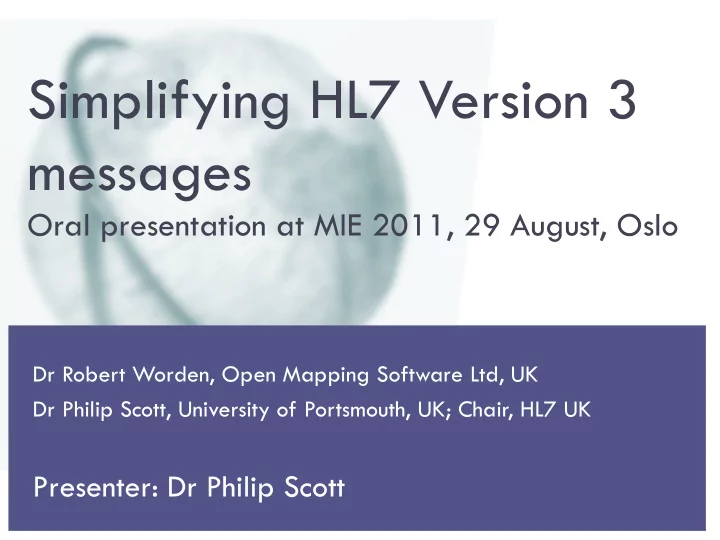

Simplifying HL7 Version 3 messages Oral presentation at MIE 2011, 29 August, Oslo Dr Robert Worden, Open Mapping Software Ltd, UK Dr Philip Scott, University of Portsmouth, UK; Chair, HL7 UK Presenter: Dr Philip Scott
Background Ø HL7 v3 offers a semantically robust paradigm for healthcare interoperability Ø All models and messages derived from the HL7 Reference Information Model (RIM) Ø Clinical Document Architecture (CDA) provides a standard model to define meaning of documents Ø HL7 v3 has been perceived as overly complex MIE2011 Slide 2 of 11 Dr Philip Scott
Background Ø Obligatory design pattern of RIM-based modelling adds complexity to the ‘natural’ model Ø RIM-based model has typically 2-3 times more classes and associations than a conventional model Ø CDA has the extra complexity of templates to define meaning of discrete elements Ø Result is deeply-nested XML with high ratio of fixed attribute ‘overhead’ to actual information payload MIE2011 Slide 3 of 11 Dr Philip Scott
Aims and objectives Ø Improve semantic interoperability by simplifying deployment and reducing costs of using HL7 v3 Ø Shallower XML nesting, fewer fixed attributes Ø Convey the payload as precisely as full v3 Ø Reliable two-way transforms to canonical format Ø Vendors enabled to interface to simplified form MIE2011 Slide 4 of 11 Dr Philip Scott
Methods Ø Map disparate structures to common UML model Ø Defined as XML schemas Ø Tools built on Eclipse framework Ø RMIM MIF imported as Ecore model Ø Analyst annotates RMIM Ø Mandatory nodes Ø Nodes to flatten Ø Meaningful names for retained nodes Ø Two-way transforms generated automatically MIE2011 Slide 5 of 11 Dr Philip Scott
Methods Templated Annotated ¡ Select V3 ¡RMIM RMIM RMIM (.mif) Rename (.ecore) (.ecore) Simple ¡ Simple ¡ Full ¡V3 ¡ Full ¡V3 ¡ ¡ Simplified ¡Class ¡ message ¡ message ¡ message ¡ message ¡ model structure mappings mappings structure ¡ (.ecore) (.xsd) (.mapper) (.mapper) (.xsd) Transform ¡ ¡ Transform ¡ ¡ simple ¡=> ¡full full=> ¡simple MIE2011 Slide 6 of 11 Dr Philip Scott
Results Ø Message simplification applied in UK project to support health and social care integration Ø NHS has defined five CDA-based messages for the Care Assessment Framework (CAF) Ø Simplified messages are typically about three times smaller than canonical v3 messages MIE2011 Slide 7 of 11 Dr Philip Scott
Results Canonical HL7 V3 fragment Simplified HL7 V3 fragment -<service code="306238000" - <entry typeCode="COMP" displayName="Domiciliary service need" contextConductionInd="true"> time="200708011420"> <npfitlc:contentId <originalText value="#a3" /> root="2.16.840.1.113883.2.1.3.2.4.18.16" </service> extension="COCD_TP146021UK06#Service" /> - <COCD_TP146021UK06.Service classCode="PCPR"> <templateId extension="COCD_TP146021UK06#Service" root="2.16.840.1.113883.2.1.3.2.4.18.2" /> - <code code="306238000" codeSystemName="2.16.840.1.113883.2.1.3.2.4.15" displayName="Domiciliary service need"> - <originalText> <reference value="#a3" /> </originalText> </code> - <effectiveTime> <center value="200708011420" /> </effectiveTime> </COCD_TP146021UK06.Service> <entry> MIE2011 Slide 8 of 11 Dr Philip Scott
Conclusions Ø The semantic mapping approach offers a viable route to wider HL7 v3 deployment Ø Applicable to any message or document type Ø Demonstrably reliable auto-generated two-way transforms Ø Maintains RIM-based semantic precision Ø Improves ease-of-use for general interfacing Ø Extensible to model-based software development and message definitions MIE2011 Slide 9 of 11 Dr Philip Scott
Future directions Ø Completion of the CAF project Ø Use in NHS Interoperability Toolkit (ITK) to lower barriers to CDA adoption Ø Potential use to simplify the CDA-based patient summary specified in the US ‘meaningful use’ criteria for electronic health records Ø Simplified model-based application architecture (“SIMBAA”) MIE2011 Slide 10 of 11 Dr Philip Scott
Thank you – Questions please Ø Philip.Scott@port.ac.uk www.hl7.org.uk www.openmapsw.com MIE2011 Slide 11 of 11 Dr Philip Scott
Recommend
More recommend